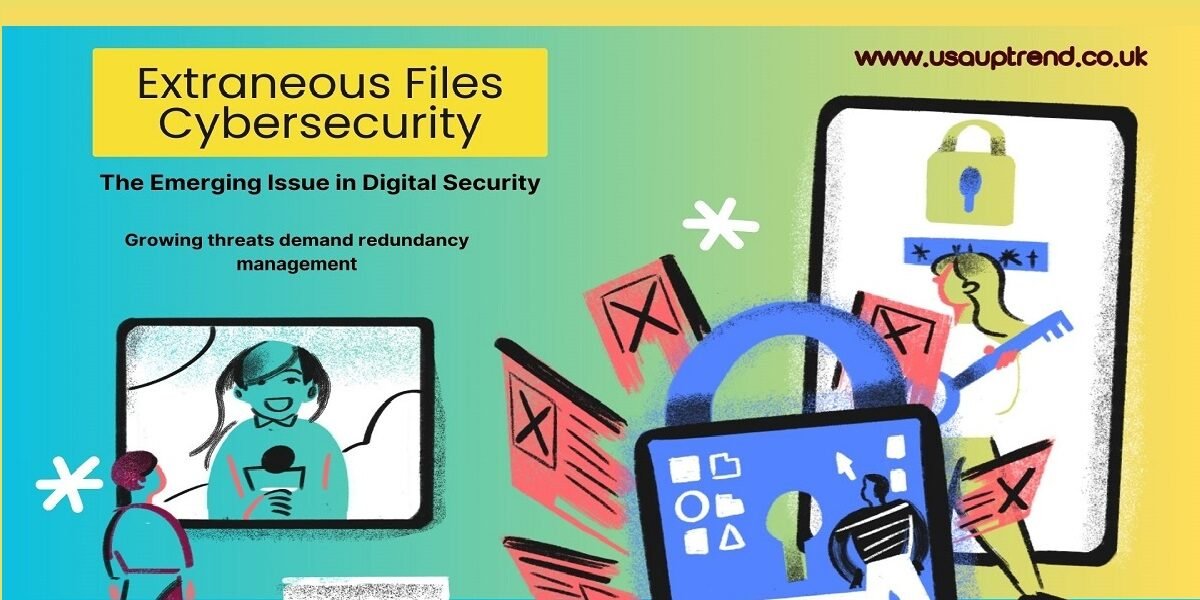In today’s digital era, cybersecurity has emerged as a key guarantor of information system continuity. While organizations and individuals face many challenges in securing sensitive information against cyber-attacks, they are continuously producing a record amount of data. Extraneous files cybersecurity has thus become one of the major concerns. Extraneous files in a system, such as obsolete backups, old versions of documents etc, are a serious threat to network security. Each of them increases risks in maintaining secure environments and is the easiest target for any cybercriminal trying to exploit vulnerability.
Overlooked Threats in Extraneous Files Cybersecurity
The irony lies in the fact that even though extraneous files cybersecurity plays a vital role, enhancing general security, many organizations fail to handle it properly. Most organizations focus more on protecting active data and network systems, often overlooking redundant or obsolete files. However, cybercriminals can use these overlooked files as an entry point to bypass otherwise secure systems. Hackers actively look for abandoned files that may contain sensitive credentials, financial data, or proprietary business intelligence. By focusing on the security of extraneous files, an organization can reduce its chances of vulnerability to cyber threats.

Unmanaged Data: A Growing Vulnerability
Extraneous files pose a big problem because people often leave them in unmanaged or insecure locations. Even though businesses invest heavily in securing active files and databases, the extraneous files linger in outdated storage systems, older servers, or unpatched backup systems. These grow over time, and soon enough, IT teams cannot manage, track, or secure these files. Without much control, cybercriminals can easily manipulate the huge risk involved and compromise sensitive data at these points.
Hidden Dangers of Unmonitored Files
Every unnecessary record is a potential attack surface. Even if a file is no longer needed for current practice, it may still pose a threat if it has resided in the network. For example, a mail archive on an ex-staff email may include secret data such as sign-on information, customer data, or strategic documents. Unless properly deleted or kept, such files are readily accessible by perpetrators. These should, therefore, be part of the general organizational security policies to ensure the elimination of vulnerabilities.
This becomes further compounded by the fact that most organizations have grossly underestimated the volume of redundant files that lie around their network. The creation and migration of digital documents consistently mask old data. For example, duplicate data frequently appears on backup systems, often without regular purging or cleaning. These in particular have been attractive for cybercriminals who may have older versions of software that have known vulnerabilities.
Compliance and Regulatory Risks
The risk is much greater when the extraneous data contains sensitive information such as financial or health records. Extraneous files may contain PII, financial information, or other types of regulated data. Organizations in many industries are under stringent data protection policies, such as GDPR or HIPAA; failing to protect or dispose of extraneous files will result in devastating legal penalties. For this reason, adhering to these regulations is a crucial aspect of file cybersecurity.
Best Practices in Handling Extraneous Files
Addressing the problem of extraneous files necessitates that an organization is proactive in handling its digital assets.
Regular Data Audits
It looks at regular auditing of data stored in identifying and categorizing the files concerning their importance, sensitivity, and relevance to operational continuity.
Retention Policies
When an organization detects extraneous files, they should securely archive or delete them according to retention policies and compliance. This helps the organization exercise due diligence and avoid keeping unnecessary data, thus minimizing risks associated with extraneous files.
Automation Tools
Besides audits of data, an organization shall invest in automation tools that make the process of identifying and managing extraneous files easier and less time-consuming. Most modern cybersecurity suites have integrated capabilities that help discover and secure digital assets across an organization’s network. These tools can automatically identify and flag files that have not been opened for a long time for review or deletion. This is quite helpful for big organizations where tracing all the files manually is impossible.
Encryption
Most of these tools also ensure that sensitive information will not be compromised, even if they are no longer in active service. Encryption and access control are the most basic parts of extraneous file s cybersecurity. Applying strong encryption, even if they remain in the network, will prevent unauthorized users from accessing extraneous files. This is exceptionally true for those files that contain sensitive or regulated data.Encryption should effect at rest when the files are actually stored and in transit during the transfer of files between systems.
Cybersecurity Training
Besides, employees need education in the sphere of cybersecurity of files and on the risk of extraneous files. Very often, employees are the first line of defense from cyber threats. Their knowledge of good practices will reduce to a minimum the occurrence of bad situations regarding information security. Training programs need to underscore the principle of securely deleting redundant files and avoiding the creation of unnecessary copies of sensitive information.
Access Control
Access control mechanisms play a very critical role in securing extraneous files. Organizations use these mechanisms to reduce the risk of unauthorized persons accessing files, depending on the individual’s role within the organization. It is crucial for organizations to apply the correct access control policies and regularly check who has accessed certain files to ensure that only the right personnel are granted permission. This is especially important for files that are commonly overlooked during standard security reviews.
Progressive Table of Extraneous Files Cybersecurity (2018–2024)
| Year | Key Developments | Challenges | Cybersecurity Focus | Emerging Trends |
| 2018 | – Initial recognition of extraneous files as a cybersecurity risk – Introduction of GDPR and stricter data regulations | – Limited tools for identifying and managing extraneous files – Organizations focus mainly on active data security | – Active file protection – Network and database security | – Data retention policies in response to regulations – Initial focus on data minimization |
| 2019 | – Growing awareness of risks posed by obsolete and redundant files – Rise in regulatory fines for mishandling extraneous data | – Lack of proper auditing and management practices for extraneous files | – Improved encryption protocols – Auditing sensitive data for compliance | – Increasing adoption of automated tools for file tracking |
| 2020 | – Surge in remote work due to COVID-19, leading to more data creation and storage issues | – Increased unmanaged and unmonitored data from remote workforces – Expansion of attack surface | – Implementation of cloud-based file management and security systems | – Automation and AI integration in file management – Cloud security tools focus on identifying redundant files |
| 2021 | – Rise in ransomware attacks, highlighting the vulnerability of unpatched and extraneous data | – Unused backups and forgotten files become key attack vectors | – Greater emphasis on regular data audits – Strengthened encryption for files at rest | – Security by design approach to data management – Increased emphasis on zero trust models |
| 2022 | – Introduction of sophisticated cybersecurity suites that integrate extraneous file management | – Difficulty in tracing legacy data and managing hybrid cloud environments | – Integration of file monitoring tools within cybersecurity frameworks | – Proliferation of AI-driven threat detection tools for file integrity |
| 2023 | – Increased compliance demands for data privacy (GDPR, CCPA, etc.) lead to fines for mishandling redundant data | – Volume of redundant data continues to grow due to hybrid work environments | – Comprehensive audits and automation in file retention and deletion policies | – Rise of cyber hygiene practices – Focus on secure deletion of extraneous data |
| 2024 | – Advanced AI-driven tools automatically detect and classify extraneous files across networks | – Complexity in securing vast amounts of unmanaged legacy data | – Adoption of AI and machine learning to identify, archive, or delete extraneous files – Stronger encryption and compliance-driven file handling | – Real-time threat monitoring for dormant and redundant files – Integration of machine learning models for predictive file risk assessment |
The following table illustrates the evolution and projected evolution of redundant file cybersecurity from key developments, challenges, and trends between 2018 and 2024: As cybersecurity threats become more sophisticated, the priority to secure and manage redundant files increases.
Types of Extraneous Files Cybersecurity Issues
Redundant Backups
These were the backups, which were no longer in use. They are much outdated and yet stored and open to vulnerabilities.
Duplicate Files
Several copies or versions of the same file create enhanced risks of breaches in security.
Obsolete Data
These include all the files that are no longer in use within the business concerns .Although, yet they are still stored within systems. This leaves the door open for exploitation
Temporary Files
Applications create files but do not clean them up even after they no longer serve a purpose in the operation of the application.. These files may become a security risk.
Unpatched Backup Systems
Backups that are not regularly updated may contain older data vulnerable to exploitation.
Old Files from Previous Employees
Old ex-employee data that may have left sensitive credentials or business information lying around.
Extraneous services as security threat
Extraneous services can be defined as applications that are not needed in the system to carry out its primary function. These extended services increase the system’s attack surface by providing additional points of access into a system. This is a cause for security concern.
- Most vulnerability come from outdated and unpatched services, which carry a lot of security flaws that hackers can manipulate.
- Poor configuration often results in services that are not well configured and have loose securities against unauthorized access.
- Detection and Control: This diminishes security visibility caused by blind spots. That brought about by the operation of services that are not necessary. Eventually, the system becomes difficult to monitor and protect.
- Mitigation: You can reduce the risk of exploitation by eliminating or turning off unnecessary services, hence improving the security system.
Conclusion
The bottom line is that forms of extraneous files cybersecurity lie at the heart of every contemporary data security strategy. If an organization can get past the direct risks of outdated, redundant, and unnecessary files, it will greatly reduce overall exposure to cyber threats. With periodic auditing, automation tools that handle data lifecycle management, and employee training, businesses can ensure proper handling and security of extraneous files. Moreover, integration of encryption and mechanisms of access control in security frameworks will even further enable an organization. It secure sensitive data against unauthorized actors. As cybersecurity threats evolve continuously, organizations must focus on ensuring that they outpace potential vulnerabilities in files cybersecurity.
read more about technology and other categories at usauptrend




